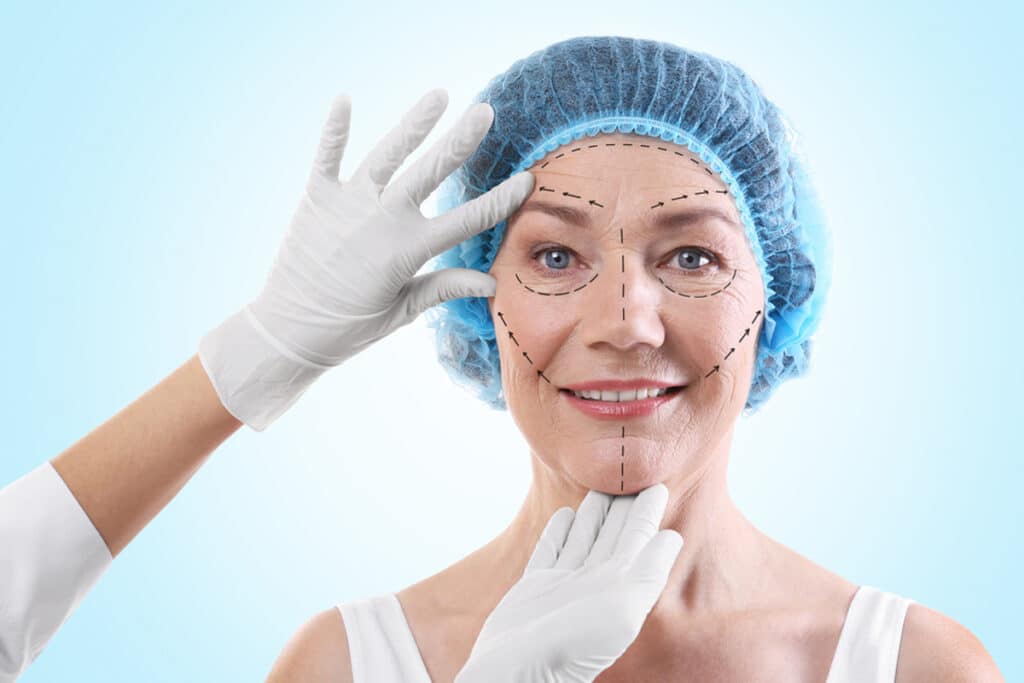Facelifts change how you look. But some scars are a normal part of how you heal. Surgeons work to place incisions where they are not seen, but a patient may still want to hide facelift scars, especially earlier on.
To reduce the visibility of scars, you can use several methods. This guide describes the best choices to help with healing and improve your confidence.

Top Solutions for Hiding Facelift Scars
- People hide facelift scars with makeup; they also use hairstyles or accessories as the skin heals.
- Silicone gel and scar creams lead to smoother scars. The scars are less visible as time passes.
- Certain treatments improve scars people see more often, which include laser therapy, microneedling, or scar revision surgery.
- Always let your incisions heal completely. Then start any treatment.
- For good results, speak with a facial plastic surgeon. An expert selects the safest and best choices for your skin.
Where are facelift scars located?
Facelift scars are usually hidden in places that blend in with your natural features. Most often, they’re found:
- Around the ears – in front, behind, or just inside the creases
- Along the hairline – especially near the temples or behind the ears
- Under the chin – if neck work is done, a small scar may be placed here
At Becker Plastic Surgery, the surgeons are trained to place incisions in a way that heals discreetly and keeps the natural shape of your face intact.
Why Post-Operative Care Matters for Scar Healing
The way you care for your skin after surgery affects how your scars heal. Even small actions change the outcome:
- Follow your surgeon’s instructions
Stick to the recommended care routine for cleaning, moisturizing, and using any prescribed products. - Keep incisions clean and dry
Gently wash as directed, pat dry, no rubbing, and avoid harsh products. - Protect scars from the sun
UV rays can darken scars. Use sunscreen (with your surgeon’s OK) and avoid direct sun. - Manage swelling early
Keep your head elevated. Use cold compresses to reduce the tension on the skin as it heals.
How Can You Hide Scars After a Facelift?
People want their scars to be less visible as their skin heals. Even when results appear good, some people prefer help to blend or fade the lines, especially during the early stages of healing.
People treat facelift scars to make them less visible; they use scar healing methods or quick cosmetic cover-ups. If scars are more noticeable after they heal, people have choices for long-term improvement.
1. Silicone Gel
Silicone gel is a reliable topical treatment for skin scars. But it doesn’t hide them; gel helps them fade over time.
Two weeks after surgery, when your incisions heal, you can put a thin silicone gel layer on the skin each day. The gel keeps the skin moist and covers it. This lowers the chance of thick or raised scars.
Regular use of silicone gel flattens scars; it improves texture and reduces redness. Always check with a surgeon before starting. This is important if the skin is still sensitive.
2. Scar Creams

Scar creams provide another way to help heal and change how facelift scars look; they have ingredients like vitamin E, onion extract, or niacinamide, which soften scar tissue. They also even out skin tone as well as add moisture to it.
The creams do not work at once, but regular use helps fade scars. Make sure your skin is completely healed first. Ask your surgeon which cream is good for you.
3. Makeup
To hide facelift scars, makeup is a simple, popular choice. Especially when your skin heals or before long-term treatments work.
With camouflage makeup, products that cover scars and discoloration, you can even out your skin tone. So, scars become less noticeable. Use a light foundation or a concealer that matches your skin and blend the product well. Do not apply too much, because heavy makeup shows the scar more.
Search for products with a non-comedogenic label, as they do not clog pores. Check with your surgeon before you put anything near healing incisions. About 10 to 14 days after surgery, most people can apply makeup, but only when the skin closes completely.
4. Hair Styling
A good haircut can hide facelift scars. Scars often show around the hairline, at the temples, or behind the ears. Hair accessories, headwear, scarves, hats, or headbands quickly cover scars that are still healing or are too visible.
You can also use certain hairstyles to naturally conceal scars:
- Loose waves or curls to add volume around the sides of the face
- Side parts or bangs to cover temple areas
- Low buns or ponytails to avoid pulling hair back too tightly
- Layered cuts that frame the face
These looks move attention from scars to your overall look. Keep anything that touches your skin soft and clean, especially during healing time.
Get expert care after a facelift procedure
Experience world-class treatment from our top-rated providers at Becker Plastic Surgery.
5. Laser Treatments
Lasers treat facelift scars that heal thick, red, or dark. The light energy smooths the skin as it causes collagen to grow. Over time, the scar feels softer, and discoloration is reduced.
Different lasers target different issues:
- Fractional lasers improve texture and mild indentations
- CO₂ lasers treat deeper scars and uneven skin
You’ll likely need a few sessions, spaced weeks apart. Just be sure your skin is fully healed, and talk with your surgeon to find the right approach for you.
6. Microneedling Therapy
Microneedling uses small needles to produce controlled, micro-injuries in the skin. This helps start the production of collagen and elastin. These two ingredients contribute to skin that appears smoother plus feels firmer.
This gentle, minimal treatment improves scar texture and evens skin tone, as well as softens indentations. Many people need a few sessions spaced weeks apart for good results.
Always wait until your skin is fully healed, and have it done by a qualified professional.
7. Scar Massage
After your incisions are healed, gentle massages on the scars can improve the hard tissue. This helps the skin’s elasticity, and the scars become less visible.
With clean fingers, move in small circles; apply light pressure for a few minutes each day. A scar gel or moisturizer helps during this process.
Be sure to check with your surgeon before starting, just to make sure your skin is ready.
8. Scar Revision Surgery
At times, even with much care, a facelift scar heals in a way that shows more than expected. As an example, it lifts, it widens, or it does not blend with the skin around it. Scar revision surgery then helps.
Scar revision does not erase a scar, but it improves its look. A facial plastic surgeon reshapes or removes the scar using closure techniques that encourage smoother healing.
Usually, this procedure takes place months after your first surgery. At that time, the skin heals completely and the scar develops. This is helpful for scars that did not heal well; this happens because of tension, infection, or individual skin variations.
If a scar looks bad after time passes, revision surgery offers another try for a better result. Consult with a facial plastic surgeon; they will change the treatment for your skin and goals.

Important considerations
Before treating or covering facelift scars, keep these key points in mind:
- The basics matter
Sun protection, gentle care, and hydration go a long way; don’t skip the simple stuff. - Healing takes time
Scars can take months to fade. Be patient and give your skin time to do its job. - Everyone heals differently
Scar formation and fading depend on a person’s age, skin and habits. A treatment that helps one person may not help another in the same way. - Wait until it’s safe
Don’t start treatments like scar creams, lasers, or microneedling until your surgeon says it’s okay. - Ask your surgeon first
Before you try a new product or treatment, always check with your doctor. A professional knows what suits your skin.
Why Choose Becker Plastic Surgery for Facelift
- Skilled Surgical Team
Our board-certified facial plastic surgeons: Dr. Schrader, Dr. Lozada, Dr. Kam, Dr. Yamasaki, and Dr. Wong bring specialized training and years of experience in facelift and scar revision techniques. - Focused on Natural Results
We tailor each facelift to enhance your features while keeping results natural and balanced. - Advanced Scar Management
From careful incision placement to revision options, we offer comprehensive care for better healing and smoother scars. - Convenient Locations
Offices in Princeton, Voorhees, Philadelphia, Yardley, Freehold, and more, making expert care accessible across NJ and PA. - Trusted by Patients
With real results and personalized care, we’re proud to be a go-to practice for facial rejuvenation in the region.
Consult with Facial Plastic Surgery Specialists
If you think about a facelift or want to improve how your scars heal, a facial plastic surgery expert is the next step.
At Becker Plastic Surgery, board-certified surgeons work for results that look natural; they offer care for each person. When it is your first procedure or you consider scar revision, they help you understand your choices. They guide you through each step.
Let us discuss what you want and design a plan that fits you. Schedule an appointment today.